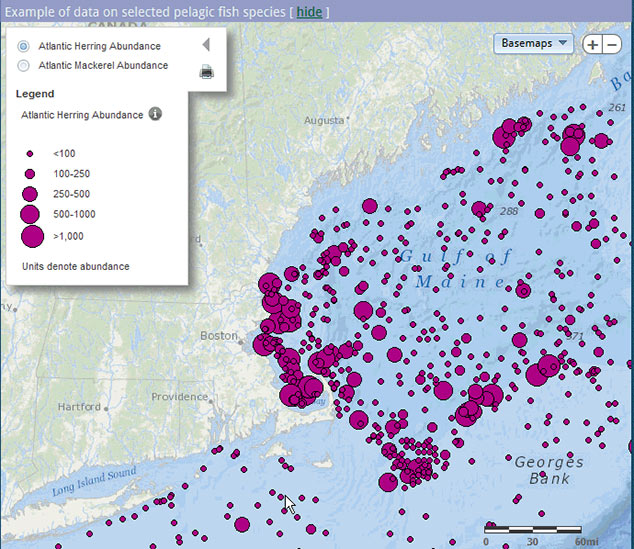Identifying Natural Resource Conservation Issues
In winter/spring 2013, ocean planning staff and Regional Planning Body (RPB) members conducted a series of meetings with 20 conservation organizations in each coastal New England state. The goal was to better understand natural resource conservation issues for ocean planning from these organizations’ perspectives. The meetings resulted in a preliminary list of conservation-related issues:
- A desire for ocean planning to identify important, significant, or valuable (different terms were used) habitat or areas and to determine how to incorporate this information into decision-making.
- The opportunity for ocean planning to inform and coordinate funding for regional science and research priorities.
- Concerns about how environmental shifts, such as those stemming from climate change and other drivers, will be incorporated into natural resource mapping and management decisions.
Mapping marine life and habitats
In 2013, in collaboration with the Northeast Sea Grant Consortium and The Nature Conservancy, ocean planning staff worked with regional scientists to develop specific recommendations for characterizing the distribution and abundance of the region’s marine life. A technical committee composed of 20 New England scientists with expertise in marine mammals, sea turtles, birds, shellfish, and finfish guided the project, which drew on existing data, models, and interviews with scientists to investigate the potential use of existing information in ocean planning. The final recommendations provided guidance for integrating existing data sources to map marine life distribution and abundance, develop measures scientific certainty, and consider the potential effects of climate change.
The RPB used these recommendations to develop a Request for Proposals which resulted in the hiring of the Marine Life Data and Analysis Team (MDAT) composed of Duke University’s Marine Geospatial Ecology Lab, NOAA National Center for Coastal Ocean Science, Loyola University, and the Northeast Fisheries Science Center. MDAT is working with the RPB, ocean planning staff, and regional scientists to develop data products and other information that characterize marine mammal, sea turtle, bird, and fish distribution, abundance, and trends.
In early 2014, through contract support from E&C Enviroscape, the RPB inventoried federal and state programs to identify datasets and products that could contribute to a regional characterization of marine life distribution and abundance. Also, guided by the Framework for Ocean Planning in the Northeast, E&C and planning staff reviewed regional efforts to identify areas of ecological importance or measure the health of the marine system. The result of this work provides the background for marine life data product development and for RPB decisions about any additional assessments it could conduct for ocean planning. The draft report can be found here. While it includes many findings, most importantly it identifies the management application as a key driver for how data products and additional assessments, such as identifying important ecological areas, are developed.
On June 25, 2014, the RPB held a Natural Resources Workshop to kick off the marine life distribution and abundance work, and to review and consider the applicability of other potential natural resource assessments for ocean planning. Over 130 participants from varied backgrounds attended the workshop and provided perspectives on data and methods for characterizing marine life distribution and abundance, and whether and how the RPB should consider additional assessments. The workshop summary is available here.

